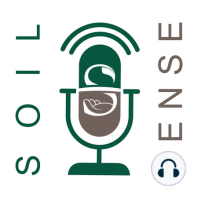30 min listen
Field Check: Residue Management
FromSoil Sense
ratings:
Length:
11 minutes
Released:
Oct 11, 2022
Format:
Podcast episode
Description
In this episode we talk about a problem that many farmers run into on their soil health journeys: residue management. But rather than just focus on one field, we’ve collected a handful of different perspectives and experiences for you. You’ll hear from two farmers and two researchers about this challenge and how they’re finding ways to maximize the benefits of residue while managing the challenges that can come with it. Farmer Sam Landman describes the problems that residue has caused on his farm in the past, and how he’s tried to address them. He is in the process of trying different seeding equipment and timing to better manage his residue issue.
“We're wrestling with high moisture in our soils, being able to get into it, and then also high residue. We have hair pinning problems with our no-till equipment, like our single disc drills and disc planters and stuff. If the residue isn't quite dry or if it's too thick it'll hair pin and then the seed won't have any soil contact and it won't come up…. so we're having residue management challenges and moisture challenges and that's the biggest thing.” - Sam Landman
Soil Scientist Dr. Caley Gasch addressed this challenge at a previous DIRT workshop. Caley has since moved from NDSU up to Alaska, but she is included in this episode to help explain how a more biologically active soil can eventually help reduce some of these residue issues. Caley’s colleague Dr. Aaron Daigh, who is now at the University of Nebraska, Lincoln speaks to the challenge of getting soil with residue to heat up in the spring. He says shallow vertical tillage might be a good option for many farmers.
“You kind of have to get a little creative by incorporating some cover crops to change those carbon-nitrogen ratios so that that residue starts to decompose. Or maybe you try strip till as sort of your transition tool to migrate into a reduced till system. But as that soil begins to recover, as those microbes and fungi and, and earthworms and insects return to that soil and boost their numbers in response to the lack of disturbance, they're gonna take care of that residue over time.” - Dr. Caley Gasch
Follow the link www.NDFieldCheck.com to participate in our next question and answer segment to share your questions and get them answered by the experts!
Connect with Soil Sense at Soil Sense Initiative
Soil Sense Podcast is hosted by Tim Hammerich of the Future of Agriculture Podcast.
“We're wrestling with high moisture in our soils, being able to get into it, and then also high residue. We have hair pinning problems with our no-till equipment, like our single disc drills and disc planters and stuff. If the residue isn't quite dry or if it's too thick it'll hair pin and then the seed won't have any soil contact and it won't come up…. so we're having residue management challenges and moisture challenges and that's the biggest thing.” - Sam Landman
Soil Scientist Dr. Caley Gasch addressed this challenge at a previous DIRT workshop. Caley has since moved from NDSU up to Alaska, but she is included in this episode to help explain how a more biologically active soil can eventually help reduce some of these residue issues. Caley’s colleague Dr. Aaron Daigh, who is now at the University of Nebraska, Lincoln speaks to the challenge of getting soil with residue to heat up in the spring. He says shallow vertical tillage might be a good option for many farmers.
“You kind of have to get a little creative by incorporating some cover crops to change those carbon-nitrogen ratios so that that residue starts to decompose. Or maybe you try strip till as sort of your transition tool to migrate into a reduced till system. But as that soil begins to recover, as those microbes and fungi and, and earthworms and insects return to that soil and boost their numbers in response to the lack of disturbance, they're gonna take care of that residue over time.” - Dr. Caley Gasch
Follow the link www.NDFieldCheck.com to participate in our next question and answer segment to share your questions and get them answered by the experts!
Connect with Soil Sense at Soil Sense Initiative
Soil Sense Podcast is hosted by Tim Hammerich of the Future of Agriculture Podcast.
Released:
Oct 11, 2022
Format:
Podcast episode
Titles in the series (100)
Lessons from 20 Years of Crop Consulting with Dr. Lee Briese by Soil Sense
